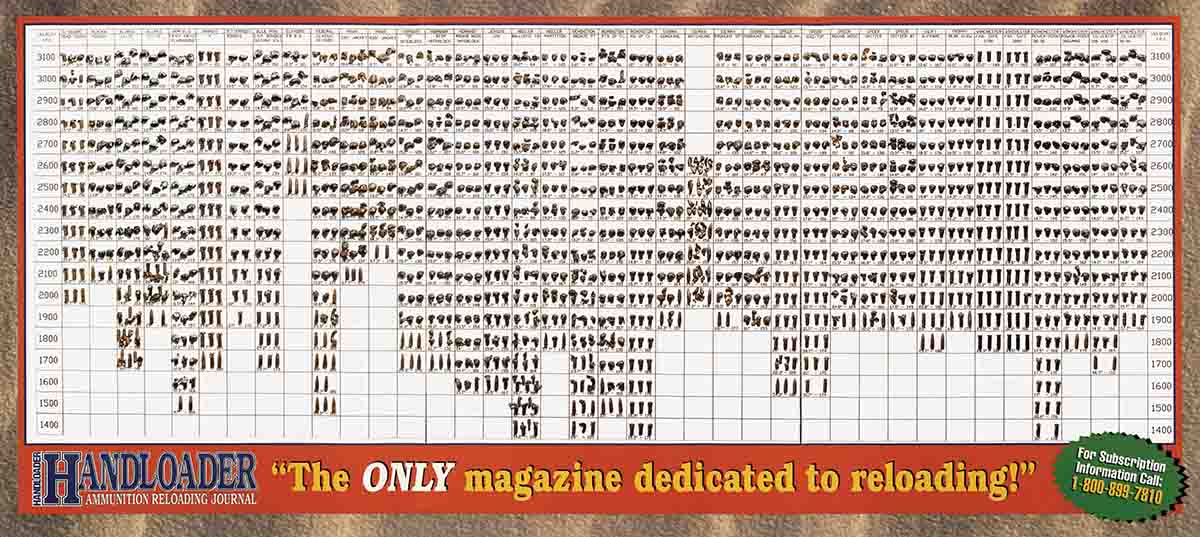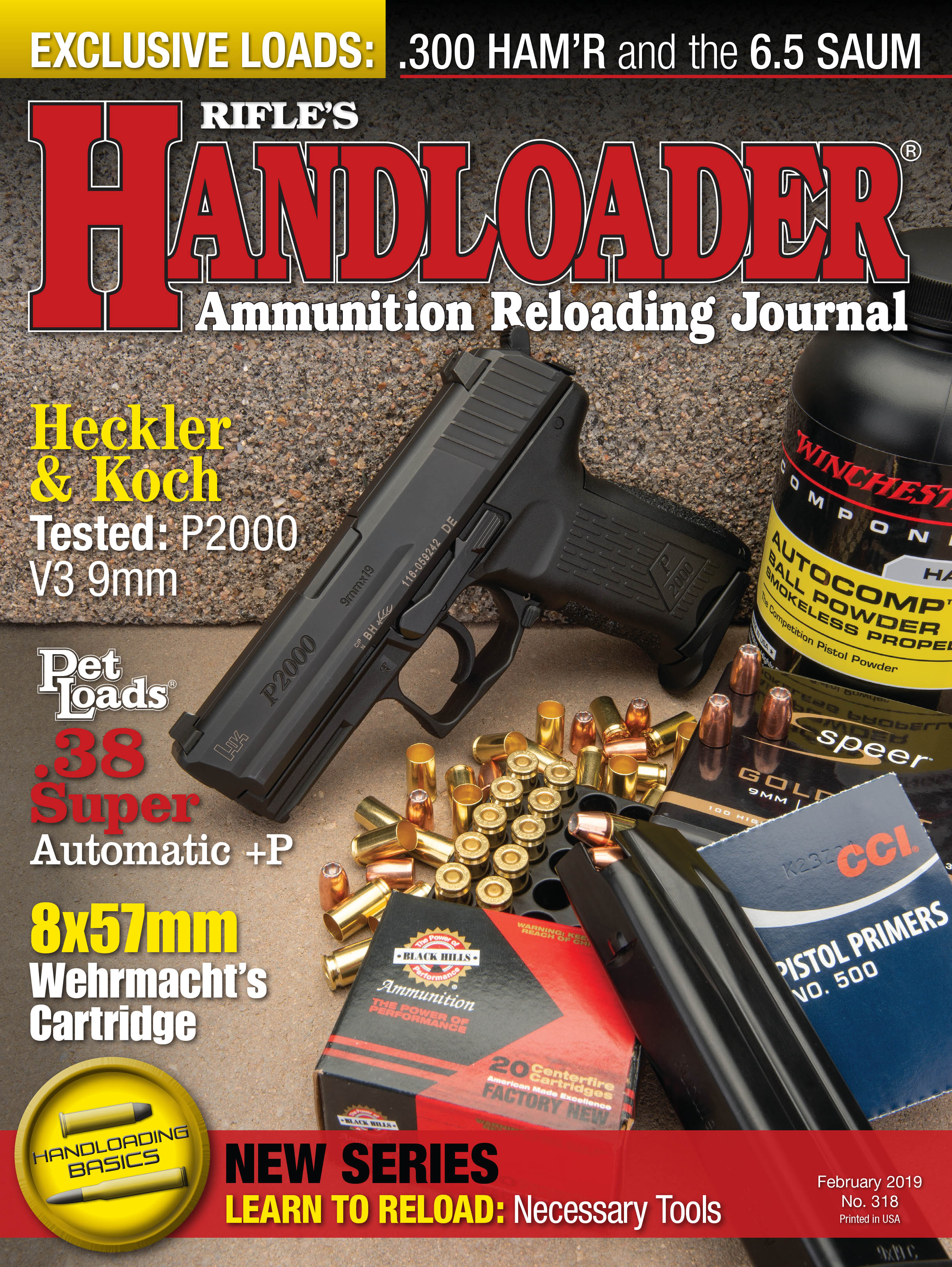Reloader's Press
Revisiting Bullet Performance
column By: Dave Scovill | February, 19

The upshot of all of the above is that BCs have little, if anything, to do with effectiveness when bullets hit big-game animals. Oddly enough, with the influx of newer bullet designs hitting the market in the last few years, little light has been shed on how bullet construction affects performance in game, which for hunting is far more important than BC.
In Handloader No. 193 (June 1998), Gary Sciuchetti summarized tests with 180-grain, .30-caliber bullets from 19 companies. The drill was to fire three bullets into wet phonebooks at impact velocities representative of downrange performance in 100 fps increments when fired from a .30-06 and .300 Winchester Magnum; 3,100 fps to 1,800 fps. Results were tabulated by depth of penetration and weight retention.
Reader response to that issue of Handloader was enthusiastic. Wolfe Publishing also sold 1,500 copies of the foldout table that featured color photos of each bullet Gary fired at respective impact velocities. Warehouse copies of Handloader No. 193 sold out almost immediately, so folks who did not have a subscription in 1998, or did not find a copy on the newsstand, were unaware of Gary’s work.
In general terms from Mr. Sciuchetti’s tests, lead-core jacketed bullets shed the most weight at high-impact velocities while penetration held at around 10 inches and remained relatively constant until impact velocities dropped to about 2,500 fps. Thereafter, weight retention remained fairly consistent while penetration increased to an average of 14 to 16 inches from 2,500 to 2,100 fps. Weight retention was quite high when impact velocities dropped below 2,100 fps, and penetration remained at a level similar to the 2,500 to 2,100 fps window.
As a rule, increased penetration below an impact velocity of 2,500 fps downrange with some bullets was largely due to a decrease in the frontal area of the mushroom. For the most part, the Winchester Power-Point generally set the standard in terms of penetration, expansion and weight retention for lead-core jacketed rifle bullets of any shape: roundnose, semi-spitzer and spitzer, boat-tail or flatbase. That also suggests that if you need a standard to compare performance in wet phonebooks or newsprint of your favorite bullet, the Winchester Power-Point is a good place to start.
Gary’s tests with lead-core jacketed bullets closely mirrored my results with several brands of 150- to 162-grain 7mm bullets, at roughly 2,500 fps impact velocity at 100 yards, that were fired into soaking wet newsprint from a 7x57mm Mauser in 1982-1983. Either way, it would appear an impact velocity of 2,500 fps or so is just about optimum in terms of weight retention and penetration for lead-core jacketed bullets then and now. At the time of my tests, flatbase jacketed hunting bullets outnumbered boat-tail, lead-core designs, mostly owing the tendency for the latter to shed their cores. Currently, a good number of boat-tail bullets have bonded cores and/or monolithic designs to improve weight retention after impact.
Mr. Sciuchetti also tested the Barnes X Bullet, the results of which fairly duplicated the current Triple-Shock (TSX) or Tipped Triple-Shock (TTSX) with maximum expansion and nearly 100 percent weight retention at high-impact velocities. Weight retention continues to be high as velocity and expansion decrease to approximately 1,900 fps at impact. In the field, that generally means the TSX and/or TTSX survives high-impact velocity without much weight loss and upwards of 20 inches of penetration, which also mirrors performance potential on larger African plains game.
Tests with the Nosler Partition and Swift A-Frame also indicated premium performance at high-impact velocities that carries through to at least 2,000 fps. Any difference between the two generally boils down to a bit more weight retention and decrease in penetration at higher impact velocities for the A-Frame compared to the Partition. Field experience with both designs suggests there isn’t enough real-time difference to quibble about when used against stout African plains game such as gemsbok or kudu.
One of the most interesting facets of Mr. Sciuchetti’s work is that the vast majority of what we might call “hunting” bullets deliver optimum performance in terms of penetration potential and weight retention with an impact velocity window ranging from 2,500 fps to 2,200 fps. If we assume muzzle velocity is approximately 3,000 fps, then it would drop to about 2,500 fps at a bit less than 200 yards, add another 100 yards for 2,000 fps, assuming an average BC of .27 to .30. At 2,700 fps muzzle velocity from a .30-06, velocity drops to 2,500 fps at around 75 yards and 2,200 fps at 175 yards.
The interesting part is that 2,500 to 2,200 fps is only slightly above the velocity window – from 50 to nearly 200 yards of a 150- to 170-grain flatnose/roundnose bullet fired from a .30-30, .303 Savage, .32 Winchester Special, etc. Which is not to ignore the .30 U.S. (.30-40 Krag), .303 British, ’03 Springfield and a double handful of other cartridges that have been putting meat on the table since the early 1900s. Most of those old relics are considered outdated by modern in-the-know writers, in spite of the fact that they represent optimum performance at average hunting ranges of 50 to 250 yards.
The big question in all of the above is, “How does bullet performance in wet phonebooks reflect actual results in the field?” In short, we might determine that most modern hunting cartridges are somewhat overpowered for deer-size game. That is, as the late John Wootters put it, “A .30-30 will drop a deer at 150 yards just as fast as a .30-06 will.” In all likelihood, the bullet fired from the ’06 will be a little worse for wear compared to the .30-30 slug, assuming shots at similar range, some of which is due to weight loss at higher impact velocities for the ’06, but is still within the application range of most .30 calibers.
None of the above suggests a bullet must be fired at optimum impact velocities and/or range to put a big-game animal on the ground. The 2,500 to 2,200 fps velocity window simply describes when the bullet is most likely to produce optimum weight retention, penetration and expansion for representative cup-and-core hunting bullets.
Of course higher velocities not only extend the effective range of the cartridge, but also contribute to excessive weight loss if taken to the extreme, e.g. point blank, which in some instances, such as hitting heavy bone, can tear a bullet up quite badly. That’s what happened to a Remington 130-grain Bronze Point fired into a buck’s shoulder from a .270 WCF at less than 15 yards some 40 years ago. The result was a nasty surface wound that required a finishing shot some time later.
Had I taken the time to test that load from up close and personal out to 300 yards or so, I might have used a different bullet and saved myself a lot of work packing that big buck out of the hole it eventually fell into. Then too, we rarely get to pick the circumstances for the shot we get in the field, unless you happen to be sitting in a blind 75 yards from a feeder in southeast Kansas.


